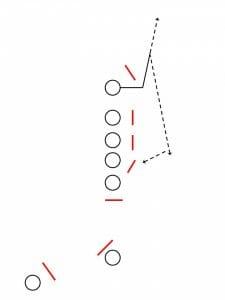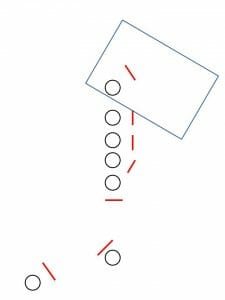Knowing the basics of a vertical stack is a fundamental tool in ultimate.
December 22, 2015 by Sean Myers in Opinion with 7 comments

The article is presented by Five Ultimate; all opinions are those of the author. Please support the brands that make Ultiworld possible and shop at Five Ultimate!
One of the most basic offenses in ultimate is the vertical stack. Because of its simplicity, it is frequently used in league play, where teams and captains have little time to delve into offensive details and intricacies.
For many new players, especially those entering league play for the first time from pick up, the vertical stack is absurd: It seems weird to stand in the middle of the field, completely covered, and wait.
However, the basic vertical stack is a crude but effective offensive system. If ultimate was a toolbox, the vertical stack would be a hammer – simple, straightforward, and effective in a surprising number of ways. Understanding the vert, its goals, and your role in achieving them as a cutter will go great lengths in your personal development as a player.
Ultimate 101 – The Vertical Stack

In its most primitive form, the vertical stack makes the game very boring. There is one cut. It comes from the back of the stack. It goes into the force side. If the defender makes it difficult to go deep, the cut goes under. If no catch is made, the cutter cycles into the front of the stack.
Rinse.
Repeat.
There are variations, of course, just like there are different models of Toyota cars. What you just read, however, is the Camry of the vertical stack – the basic model that lots of people use and which tends to get the job done.
The Goal Of The Vertical Stack
The main point of the vertical stack is to isolate a match up and play one-on-one in an open lane. It relies on the fact that, in ultimate, it’s impossible to defend every possible offensive opportunity.

When everyone else stays still in the middle of the stack, it isolates the player at the back of the stack – the active receiver or the initiator – against his or her defender. The initiator can either go deep or go under, in a lane where the thrower should theoretically have an open throw. That single defender gets put on the spot: They’re unlikely to be able to take away both cuts, and have to make a choice. If they choose to prevent one cut from happening, they’re usually opening the door for the other to happen easily.
The vertical stack is all about pushing the defender at the back of the stack to make that choice, and then taking advantage of the option that they left unguarded.
Know Your Role in the Stack
Where you are (and where you’re about to be) in the stack will determine what you should be doing.
Back of the Stack
If you’re in the back of the stack when the handler has the disc, you’re the initiator.
Cut.
Cut hard.
People will care if you don’t get open. But people will care an awful lot more if you don’t cut. By not cutting, you’re creating confusion in the rest of the stack, and putting the handler with the disc in a position where they’re forced to make a play with a throw.
This is not how the vertical stack is structured to run. It’s supposed to be a flow of cutters, coming from the back of the stack, into the force side, and cycling back into the front of the stack. Like a whirlpool. By not cutting, you stop that whirlpool, and the whole system comes to a crashing halt. So cut.
Second From the Back of the Stack
If there’s one teammate behind you in the vertical stack, your job right now is to do nothing.
However, remember that the player at the back has one job – cut. When they do, you’re at the back of the stack. Get ready, because you’re about to be isolated against your defender very soon.
Pay attention to whether the initiator gets the disc or not. If they do, your job is still to cut, but how you cut is very different. Instead of the disc being stagnant, the disc is now in flow, so your defender doesn’t know where it is on the field of play. This will often open up lanes for you to attack that otherwise wouldn’t be there. Exploit them.
Third or Fourth From the Back of the Stack
Your job is to create space. When you’re in the middle of the stack, the best way to do that is by standing still. Pay attention to how many teammates are behind you in the stack, so you can anticipate when it will be your turn to cut.
Also pay attention to your defender. A great way for the defense to stop a vertical stack is by poaching out from the middle or front to stop under cuts. If you see your defender doing this, make them pay: Cut into the break side of the field, away from your poaching defender. This gives your handler a quick opportunity to hit you with a devastating break throw that creates huge flow in a vert. If you’ve taken three to five strides into the break side and not gotten the disc, turn your cut deep. The defense will be confused, you will be open, and you will be starting your cut from the break side and close to the handler, making you a great target for a huck.
Defenders near the back of the stack will be forced to either prevent the huck or cover their own player. Either you’ll get thrown to, or you’ll peel off defenders so someone else will have an easy catch and be set up to make a great continuation throw.
Front of the Stack
The front of the stack is generally reserved for handlers, to create lateral movement and swing passes. If you’re a newer player, unfamiliar with the timing of these cuts and the throw progression that you should be making, you should avoid putting yourself in this position. If you need to clear back into the stack after making a cut, clear to the spot behind the handler in front.
The Break Side
One of the vertical stack’s powers is that it splits the field down the middle. If the offense can move the disc into the break side, the flow is quick, easy, and powerful because all of the upfield defenders are suddenly three steps out of position. If you’re cutting in the vertical stack, keeping several things in mind will help you get your team access to the break side of the field.
Know your thrower. Some handlers make a priority of attacking the break side, especially early in the stall count. Provide that opportunity by making a cut out of the stack and into the break side of the field.
Also know the matchup on the disc, and note the mark’s positioning. If the mark seems out of place, or is taking away a lot of the force side, consider making a break cut and giving your thrower a chance to exploit the mark’s aggressiveness or oversight.
Also know your team’s cutting preferences. Some teams only want break side cuts to come from the handler at the front of the stack. Other teams have a more relaxed, “take it if it’s there” approach. Ask your captain. If your team doesn’t have a preference and you see an opportunity, take the initiative.
How To Know You’re Doing It Wrong
Providing real-time feedback is often difficult in ultimate. Too much happens on the field for every mistake to be corrected properly off the field, and many players yell at newer players on the field when they do something wrong.
Cutting Too Late
If you’re in the back of the stack, you’ll know that you took too long to cut if you see an experienced player busting out of the middle of the stack and cutting you off. Experienced players or captains will often see that the stack has stopped flowing, and take it upon themselves to right the ship. You may have been just about to make your cut when this happens, and get discouraged that you got cut off. Next time, anticipate when it will be your turn, and start up a little earlier.
Cutting Too Early
If you make a cut when you’re not at the back of the stack, you’ll likely cut off the initiator, as they make their move from the back of the stack. There will be groaning – you’ve just brought your defender into the throwing lane so that you could try a cut in limited space that would net fewer upfield yards. Get back in the stack and wait for it to be your turn.
Being Too Stagnant
If you’re in the middle of the stack, but your defender manages to get a poach block on an under cut, that’s on you. You were too complacent, letting your defender take advantage of you and jump into the throwing lane. Just because you’re in the middle of the stack doesn’t mean that you’ll never cut – just having the aura of someone who’s looking for every opportunity to get open can keep your defender on their toes and close to you.
Conclusion
Cutting out of the vertical stack is often the first thing that new players will have to learn how to do on offense. Learning what the goals of the vertical stack are, and how you can help your team achieve them, will make you a much better teammate to have, get you the disc more often, and make competitive play much more enjoyable.